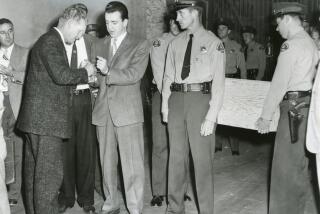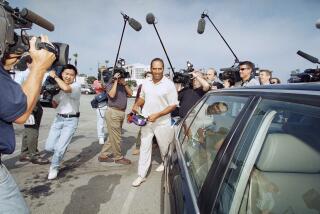To Labor, Joe Hill Will Never Die : Unions: Organizer was executed for murder 75 years ago, but his defenders say he was framed. Utah activists plan events to commemorate his work this November.
SALT LAKE CITY — As the 75th anniversary of his execution nears, Joe Hill lives on in the efforts of unionists, in the animus of the grandson of the man he was convicted of killing--and in dreams.
“I dreamed I saw Joe Hill last night, alive as you and me,” goes the union organizers’ song, and it is the labor movement that is most eager to memorialize the man it claims as a martyr.
“I would imagine that if Joe Hill was alive today, he would say the same thing as he did 75 years ago, basically, ‘Don’t agonize, organize,’ ” says Utah AFL-CIO President Ed Mayne. His union has proclaimed 1990 the “Year of Joe Hill.”
The Joe Hill Organizing Committee, made up of local union representatives, historians and community leaders, plans to honor “Joe Hill, the man--organizer, poet and songwriter--and his contributions to the human race and workers of his time,” Mayne said.
There will be art and music shows, a high school writing contest and a Nov. 15-17 labor history conference at the University of Utah. The group also plans a Nov. 19 candlelight vigil at the spot where Hill was executed.
John G. Morrison won’t be paying any homage. The grandson and namesake of John G. Morrison, the Salt Lake City grocer killed during a robbery by two masked robbers, is sure Hill was guilty.
“No one’s going to make him innocent by propaganda, I hope,” said Morrison, whose father, Merlin Morrison, was the only eyewitness to the crime. “There was absolutely no doubt in my father’s mind about what he saw.”
The focus of all this attention is a man of mystery, a Swede who immigrated in 1902 and drifted across the country before becoming a maritime worker in San Pedro, Calif. There, in 1910, he joined the Industrial Workers of the World, a radical union known as the Wobblies.
His career on the fringe was short and turbulent. He traversed the country as an IWW organizer; he fought in the Mexican revolution; he wrote labor songs, among them “The Preacher and the Slave” and “Casey Jones--The Union Scab.”
In June, 1913, Hill had a run-in with the law--he was arrested in San Pedro and charged with a streetcar robbery, but charges were dropped when no one identified him as the holdup man.
Then he left for Chicago, stopping in Utah to earn money for the rest of the trip. He lost a job in the Park City mines due to illness, and was staying with Swedish friends in Murray when he was arrested on Jan. 13, 1914.
Three days earlier, Morrison and his 17-year-old son, Arling, had been shot to death in a robbery as his other son, Merlin, then 13, looked on.
The boy testified that Hill was the same height and build as one of the killers, but he was unable to conclusively identify Hill as the perpetrator.
In the end, it didn’t matter. Prosecutors persuaded the jury that a chain of circumstantial evidence was enough. Perhaps more damning was Hill’s refusal to offer more than a cursory explanation of a gunshot wound he sustained the night of the robbery.
Merlin Morrison, who died in 1983, testified that before Arling was gunned down, he shot one of the assailants. Hill said he had been wounded in the chest during a fight over a woman, but would give no details.
The victim’s grandson, now 56, is certain. “The evidence was strong enough that the jury system, and all the people who were alive and could do something about it at the time, were convinced he was guilty,” he said.
But the AFL-CIO’s Mayne is convinced Hill was railroaded, possibly with the blessings of “copper barons” worried about IWW efforts to organize the mines.
“I think that in today’s justice system, he would never have been convicted,” Mayne said. “But (the Morrisons) have to live with their convictions, and we will with ours.”
Brian Barnard, a Salt Lake attorney and member of the Joe Hill committee, acknowledges he has some nagging doubts about Hill’s innocence, but says Hill’s trial was a travesty.
“My focus, and this is my lawyer training coming out, is whether guilty or not, he didn’t get a fair trial,” Barnard said. “There’s always going to be questions whether he was guilty, but not on whether he got a fair trial.”
In addition to the lack of positive ID, the trial was beset by what Barnard says were serious errors warranting reversal, or at least a new trial.
Prosecutor E. O. Leatherwood was allowed, in his concluding remarks to the jury, to say that Hill’s failure to testify imputed guilt--a maneuver that trampled the guarantee that no presumption of guilt can be attached to a defendant’s refusal to testify.
But perhaps the most controversial error occurred when Judge M. L. Ritchie’s instructions to the jury ignored Utah Supreme Court rulings that circumstantial evidence must be considered as a chain, no stronger than its weakest link. Ritchie told the panel to consider the evidence as a whole.
Inexplicably, Hill’s attorneys failed to raise the issue in their unsuccessful May 28, 1915, appeal.
Over that summer, Hill’s cause drew international attention. Union sympathizers wrote thousands of letters, and President Woodrow Wilson’s pleas for mercy were echoed by the Swedish ambassador and Helen Keller, among others.
On Nov. 17, in the second of two telegram appeals to Spry, Wilson urged “a thorough reconsideration” of the case. The Utah governor responded by accusing the President of meddling.
“Your interference in the case may have elevated it to an undue importance,” Spry wrote. Hill’s case had had “more careful and painstaking consideration . . . than any other like case in the history of the state.”
Hill himself gave his posthumous career as the working man’s saint a boost with memorable, sardonic wit. “I am going to get a new trial or die trying,” he said after his June 28, 1914, conviction.
Even on the eve of his Nov. 19, 1915, execution, Hill couldn’t resist a sly slap at the state.
“I die like a true rebel. Don’t waste any time mourning--organize!,” he wrote in farewell to IWW General Secretary William (Big Bill) Haywood.
Then, he added: “It is a hundred miles from here to Wyoming. Could you arrange to have my body hauled to the state line to be buried? I don’t want to be found dead in Utah.”
Shortly before 8 a.m. the next day, a five-member firing squad shredded the paper target pinned over 36-year-old Hill’s heart. His ashes, placed in envelopes and distributed to IWW locals, were released to the winds on May Day 1916 across the country and around the world.
Everywhere, that is, except in Utah.
More to Read
Sign up for Essential California
The most important California stories and recommendations in your inbox every morning.
You may occasionally receive promotional content from the Los Angeles Times.










